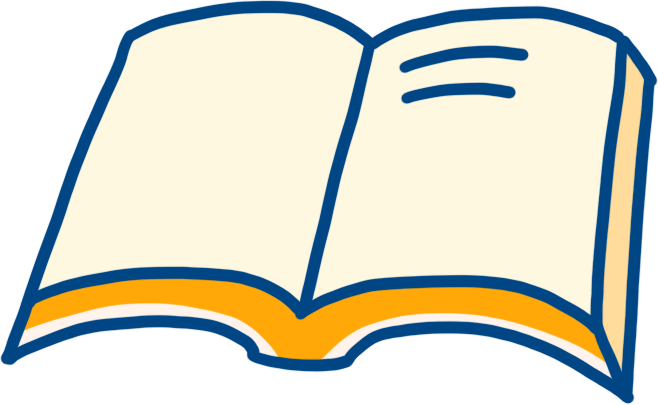
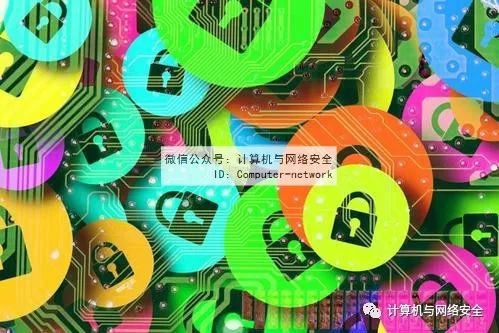
The Internet of Things (IoT) is a complex system that integrates related technologies such as computing, communication, and control, and thus faces more complex information security issues.
The IoT represents the direction of future development in computing and communication technology and is considered the third wave of development in the information industry, following computers and the Internet.
Initially, the IoT referred to a networked real-time information sharing system for items globally realized through Internet technology, Radio Frequency Identification (RFID) technology, and Electronic Product Code (EPC) technology.
Later, the IoT gradually evolved into a complete information industry chain that integrates traditional telecommunications networks, computer networks, sensor networks, point-to-point (P2P) wireless networks, cloud computing, and big data as part of Information and Communications Technology (ICT).
1. Concept of IoT
Since 2007, with the rapid development of network technology, communication technology, and smart embedded technology, the term “Internet of Things” has frequently appeared in public discourse. The concept of IoT has attracted widespread attention from academia and industry, particularly for its expected role in stimulating global economic recovery and development, helping the world through the economic crisis from 2008 to 2010. IoT technology has brought about a new technological revolution and has promoted the development of cloud computing, big data, and artificial intelligence.
Despite its years of development, the definition of IoT has not yet been unified. The general English name for IoT is “Internet of Things.” As the integration of people, machines, and objects deepens, the IoT is also referred to as the “Internet of Everything” (IoE).
As the name suggests, the IoT is an interconnected network that connects all objects. As a new technology, its definitions vary widely. Currently, a widely accepted definition is: the IoT is a network or system that connects any object to the Internet for communication and information exchange using information collection devices or systems such as RFID readers, sensors, infrared sensors, global positioning systems, and laser scanners, according to agreed protocols, to achieve intelligent identification, positioning, tracking, monitoring, and management.
From the above definition, it is clear that the IoT includes the following four components.
1) Diversified Perception: Diverse sensing devices, including traditional temperature and humidity, pressure, flow, and position sensors, as well as new smart sensors, support the digitalization of the physical world and the localization of personnel.
2) Electronic Identity: Using electronic tags (Tags), QR codes, visuals, and sounds for identity recognition facilitates the construction and use of information systems, supporting the identification and tracking of personnel and objects.
3) Multi-mode Communication: This includes various wireless and wired communication methods such as Bluetooth, wireless communication technologies (like Wi-Fi), and Near Field Communication (NFC) technologies for short-range wireless communication, as well as 4th Generation Mobile Communication Technology (4G), 5th Generation Mobile Communication Technology (5G), and microwave communication technologies for mid-range wireless transmission, and satellite communication technologies for long-range wireless transmission.
4) Intelligent Management: Through in-depth analysis and visualization of perception data, effective monitoring and management of the physical and information worlds can be achieved to enhance the intelligence of IoT systems.
Clearly, in the definition of IoT, “computing,” “transmission and communication,” and “detection and control” are organically integrated, making IoT a typical new technology that merges the three Cs (Computer, Communication, Control).
From the definition of IoT, it can also be seen that the IoT is an extension and expansion of the Internet, with its user end extending to any object in the world. The International Telecommunication Union (ITU) pointed out in its “ITU Internet Report 2005: Internet of Things” that in the IoT, a toothbrush, a tire, a house, or even a tissue can serve as network terminals, meaning that any object in the world can connect to the network. The information exchange between objects no longer requires human intervention, enabling seamless, autonomous, and intelligent interaction between objects. In other words, the IoT is based on the Internet and primarily addresses the interconnection and communication issues between people, between people and objects, and between objects.
In addition to the definitions above, the IoT also has several representative descriptions internationally.
International Telecommunication Union:From a three-dimensional perspective of time-space-object, the IoT is a dynamic network capable of interconnecting any object (Anything) at any time (Anytime) and in any place (Anyplace), including interconnections between personal computers (PCs), between people, between objects and people, and between objects.
European Commission:The IoT is an extension of computer networks, a network that achieves interconnection between objects; these objects can have Internet Protocol (IP) addresses, embedded in complex systems that acquire information from the surrounding environment through sensors and respond to and process the acquired information.
China IoT Development Blue Book:The IoT is a vast network that connects various objects to the Internet through information technology, helping people obtain relevant information about the objects they need; the IoT connects objects to the Internet through wireless sensor networks and wireless communication networks, achieving real-time communication and information exchange between objects and between people and objects, to achieve intelligent identification, positioning, tracking, monitoring, and management.
2. IoT Architecture
Understanding anything requires a process from the whole to the part, especially for complex systems with diverse functions, and the IoT is no exception. First, it is necessary to understand the overall structure of the IoT; then, discuss the details. The IoT has an open architecture, and due to its developmental stage, different organizations and research groups propose different architectures for the IoT. However, whether it is a three-layer architecture or a four-layer architecture, the key technologies are interconnected and similar. Below is an introduction to one of the four-layer architectures of the IoT, which can be combined to achieve a three-layer architecture.
Currently, when researchers describe the architecture of the IoT, they often base it on the ubiquitous sensor network (USN) structure proposed by the ITU-T in 2002, which is divided into four layers from bottom to top: sensing network layer, ubiquitous access layer, middleware layer, and ubiquitous application layer, as shown in Figure 1.
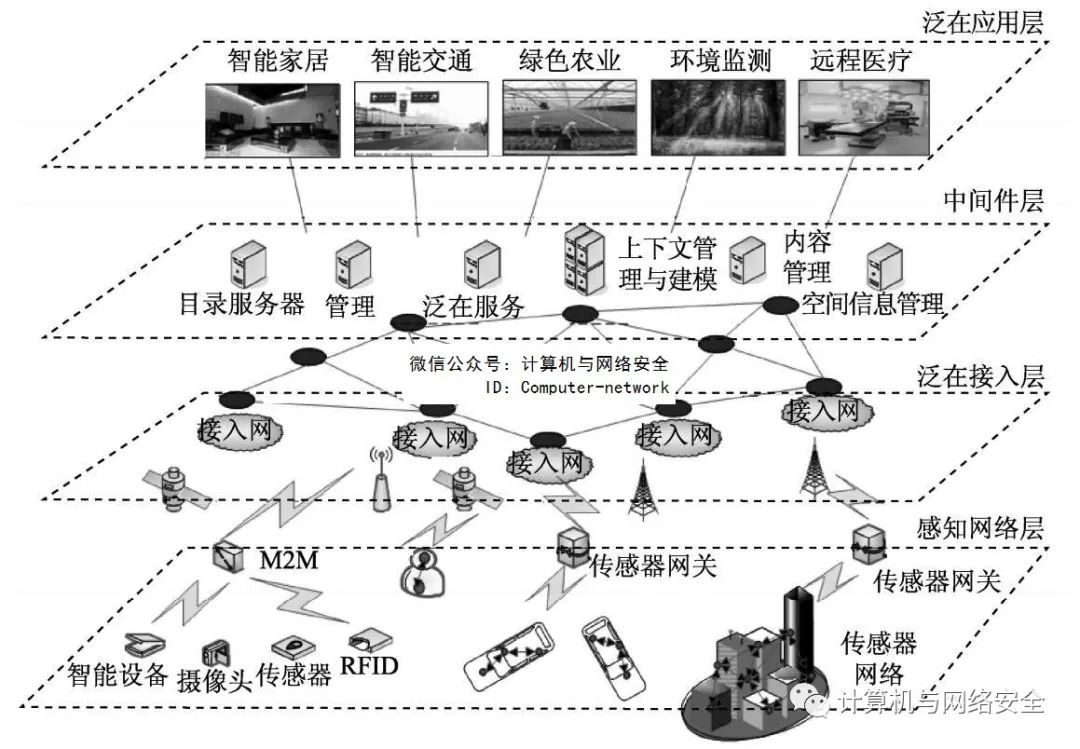
Figure 1 USN Structure of IoT
A major feature of the USN structure is its reliance on the Next Generation Network (NGN) structure, where various sensors form a ubiquitous network environment closest to the user, and users use various services in this environment, with NGN serving as the core infrastructure to support USN.
Clearly, the USN-based architecture of the IoT primarily describes the role of various communication technologies in the IoT and does not fully reflect the functional set division, networking methods, interoperability interfaces, management models, etc., in the implementation of IoT systems, which is not conducive to the standardization and industrialization of the IoT. Therefore, further exploration of key technologies and methods for implementing IoT systems is needed to design a general IoT system structure model.
Figure 2 presents a general four-layer architecture of the IoT. This structure focuses on the qualitative description of the IoT rather than the specific definitions of protocols. Thus, the IoT can be defined as a four-layer architecture that includes the sensing control layer, data transmission layer, data processing layer, and application decision layer.
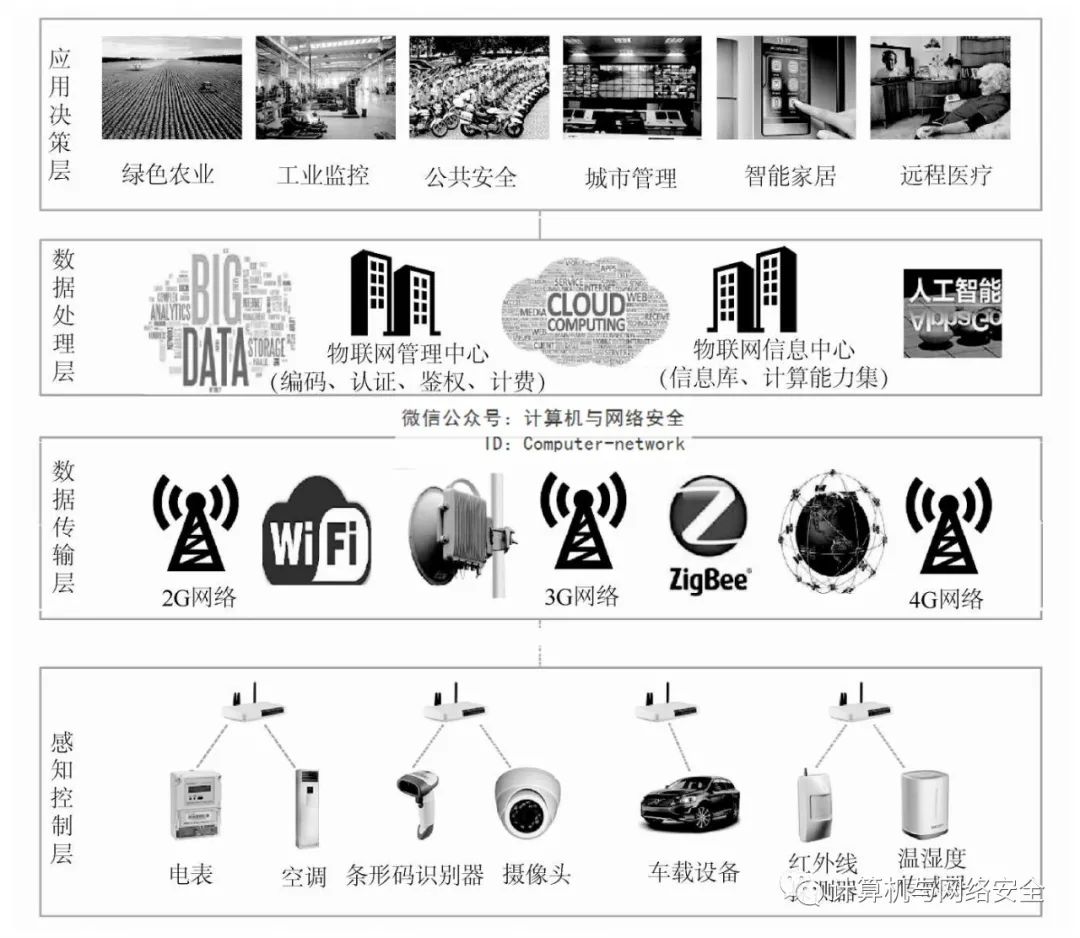
Figure 2 Four-layer Architecture of IoT
This architecture draws on the USN structure concept of ITU, adopting a bottom-up layered structure. The functional descriptions of each layer are as follows.
Sensing Control Layer:The sensing control layer, abbreviated as the sensing layer, is the foundation for the development and application of the IoT, including barcode readers, various types of sensors (such as temperature and humidity sensors, video sensors, infrared detectors, etc.), smart hardware (such as electric meters, air conditioners, etc.), and gateways. Various sensors sense relevant information about the target environment, self-organizing networks to transmit information to the gateway access point, which then submits the collected data to the data processing layer for processing through the data transmission layer. The results of data processing can be fed back to the sensing control layer as a basis for implementing dynamic control.
Data Transmission Layer:The data transmission layer is responsible for receiving data from the sensing control layer and transmitting it to the data processing layer, subsequently feeding back the data processing results to the sensing control layer. The data transmission layer includes various networks and devices, such as short-range wireless networks, mobile communication networks, and the Internet, and can achieve integration between different types of networks, as well as efficient, secure, and reliable transmission of IoT sensing and control data. In addition, the data transmission layer also provides routing, format conversion, address conversion, and other functions.
Data Processing Layer:The data processing layer can initialize IoT resources, monitor the online operating status of resources, coordinate the work between multiple IoT resources (such as computing resources, communication devices, and sensing devices), achieve interaction, sharing, and scheduling between cross-domain resources, and realize semantic understanding, reasoning, decision-making, as well as querying, storing, analyzing, and mining data. The data processing layer utilizes technologies such as cloud computing, big data, and artificial intelligence (AI) to efficiently store and deeply analyze sensing data.
Application Decision Layer:The application decision layer uses the analyzed and processed sensing data to provide users with various types of services, such as retrieval, computation, and reasoning. IoT applications can be categorized into monitoring types (logistics monitoring, pollution monitoring), control types (smart transportation, smart home), scanning types (mobile wallets, highway toll collection without stopping), etc. The application decision layer can formulate service content that adapts to different categories of applications.
Furthermore, each layer of the IoT should also include security, fault tolerance, and other technologies, which run through all levels of the IoT system to provide users with safe, usable, and reliable application support. In the four-layer architecture of the IoT, the data processing layer and application decision layer can be combined into one, referred to as the application decision layer, thus transforming the IoT four-layer architecture into a three-layer architecture, namely the sensing control layer, data transmission layer, and application decision layer.
3. Characteristics of IoT
From the definition and architecture of the IoT, it can be seen that the core functions of the IoT include the perception, transmission, and processing of information (data). Therefore, to ensure efficient operation, the IoT should possess three characteristics: comprehensive perception, reliable transmission, and intelligent processing. Figure 3 provides a description of the three major characteristics of the IoT.
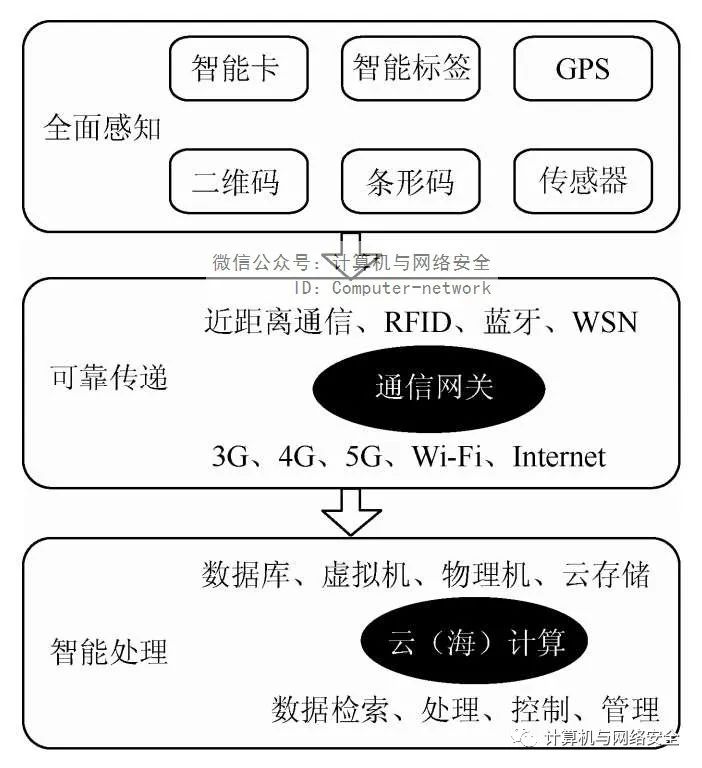
Figure 3 Three Major Characteristics of IoT
1) Comprehensive Perception: “Perception” is the core of the IoT. The IoT consists of items and people with comprehensive perception capabilities. To enable items to have perception capabilities, various types of identification devices, such as electronic tags, barcodes, and QR codes, need to be installed on the items. At the same time, physical properties and personalized features can be sensed through recognition devices such as temperature and humidity sensors, infrared sensors, and cameras. Using these devices, information about items can be obtained anytime and anywhere, achieving comprehensive perception.
2) Reliable Transmission: The stability and reliability of data transmission are key to ensuring interconnectivity between objects. Since the IoT is a heterogeneous network, there may be differences in protocol formats (specifications) between different entities, so protocol format conversion through corresponding software and hardware is needed to ensure real-time and accurate transmission of information between items. To achieve information exchange between objects, data from different sensors must be uniformly processed, necessitating the development of communication gateways that support multi-protocol format conversion. Through communication gateways, the communication protocols of various sensors can be converted into a pre-agreed unified communication protocol.
3) Intelligent Processing: The goal of the IoT is to achieve intelligent identification, positioning, tracking, monitoring, and management of various items and people. This requires support from intelligent information processing platforms that utilize intelligent computing technologies such as cloud computing and artificial intelligence to store, analyze, and process massive amounts of data, and implement intelligent control over items and people according to different application needs.
Thus, it can be seen that the IoT integrates various information technologies, transcending the limitations of the Internet, connecting physical objects to information networks, achieving an “interconnected network of objects.” The IoT supports the expansion, extension, and breakthrough of information networks towards comprehensive perception and intelligent applications, thereby affecting all aspects of the national economy and social life.
4. Origin and Development of IoT
(1) Origin of IoT
The concept of the IoT can be traced back to 1995 when Bill Gates predicted the future development of information technology in his book “The Road Ahead.” The book described some application scenarios after items are connected to the network, which can be considered the earliest prototype of the IoT concept. However, due to the limitations of wireless networks, hardware, and sensor device development at that time, it did not attract enough attention. “The Road Ahead” is accessible and full of wisdom and foresight, becoming one of the best-selling books worldwide in 1996. The following content in the book is closely related to our current social life.
1) New models of music sales will emerge. Music stored on consumables like CDs and tapes has long been troubled by storage issues due to the wear and tear of their storage media. In the future, music will be stored on a server for users to download and play via the Internet. The first-generation Apple player (internet Portable audio device, iPod) was released on October 23, 2001, with a capacity of 5GB. The iPod brought a new development idea to MP3 players, and similar products have emerged in the market, but the iPod has remained sought after due to its unique style.
2) In the future, users can choose to watch their favorite programs instead of passively waiting for TV stations to broadcast. Video on Demand (VOD) systems can transmit video content clicked or selected by users. Video on demand services have emerged as new media forms in recent years, resulting from the integration of computer technology, network communication technology, multimedia technology, television technology, and digital compression technology. Video on demand systems have become part of our daily entertainment, as platforms such as iQIYI, Youku, Baidu Video, Tencent Video, and Storm Video have integrated into our lives.
3) Two neighbors watching the same TV series at home might see completely different programs during commercial breaks: the middle-aged couple’s TV might show a retirement financial service ad, while the young couple’s TV might show a vacation travel ad. Modern home TVs now have features like program replay and ad insertion. By deeply analyzing viewing data, different ads can be inserted for different audiences, which will soon become a reality.
4) If you plan to buy a refrigerator, you won’t have to listen to those talkative salespeople, as various formal and informal evaluation information will be available on an electronic bulletin board, and the traditional in-person sales model will increasingly be replaced by online shopping. Currently, the core factor determining user online shopping on e-commerce platforms is the “reputation” of the product.
5) A camera that has been lost or stolen will automatically send back information to inform the user of its current location, even if it is in another city. Currently, taking photos and videos has become an essential feature of mobile phones. Mobile phones are increasingly important to users, and manufacturers have been working to reduce indirect losses caused by lost phones. For example, Apple has added a recovery feature to the iPhone, which can even lock the phone, making found phones nearly useless, significantly increasing the chances of recovery. Some other brands have similar features now.
6) If a child needs pocket money, parents can transfer money from their computer wallet. Additionally, when we pass through airport security, the computer wallet will connect to the airport ticketing system to verify whether the user has purchased a ticket. Clearly, it is now convenient to transfer money to children using functions like Alipay or WeChat, and even to take buses, high-speed trains, and planes by scanning codes with mobile phones.
7) In the future, people watching the movie “Gone with the Wind” can replace famous actors in the film with their own faces, truly experiencing what it feels like to be a star. Currently, virtual reality (VR) and augmented reality (AR) technologies allow individuals to immerse themselves in virtual or real scenarios, such as virtual experiments, virtual 3D makeup, and virtual 3D fitting.
8) People can personally enter maps to easily find every street or building. Currently, viewing 3D street views on maps has become a reality, but integrating individuals into street views still needs to be realized.
Thus, it can be seen that ideals are the source of innovation and the driving force for development. Only with ideals can there be innovation.
(2) Development of IoT
In 1998, the Massachusetts Institute of Technology proposed a unique coding scheme based on RFID technology, namely the Electronic Product Code (EPC), and based on EPC, researched automatic identification technology for obtaining item information from the network.
On this basis, in 1999, the Auto-ID Laboratory in the United States first proposed the concept of the “Internet of Things.” Researchers used item coding and RFID technology for item identification, connecting RFID devices and various information sensing devices like laser scanners through the Internet to achieve intelligent identification and management of items.
At that time, the definition of IoT was still very simple, mainly referring to the combination of item coding, RFID, and Internet technologies to achieve automatic identification and information sharing through the network.
The formal proposal of the IoT concept was in the ITU’s “ITU Internet Report 2005: Internet of Things.” This report expanded the concept of IoT, proposing the 3A interconnection of items, meaning interconnection between any time, any place, and any object, greatly enriching the content of the IoT concept and expanding the involved technology fields from RFID technology to sensor technology, nanotechnology, smart embedded technology, intelligent control technology, and ubiquitous communication technology.
In 2007, the United States built the world’s first citywide wireless sensor network in Cambridge, Massachusetts. In January 2009, IBM’s CEO proposed the concept of a “Smarter Planet,” emphasizing the application of sensing technologies and recommending the construction of smart infrastructure.
1) International Plans
In June 2009, the European Commission officially proposed the “EU Internet of Things Action Plan.” This plan emphasizes the widespread application of RFID and focuses on information security and privacy protection in IoT environments.
In August 2009, Japan proposed the i-Japan strategy, emphasizing e-government and social information service applications.
The common point of the above plans is to integrate various information technologies, break through the limitations of the Internet, connect objects to information networks, and realize the “Internet of Things”; based on ubiquitous networks, applying information technology to various fields, thus affecting all aspects of the national economy and social life; the development of the information industry is expanding and breaking through from information networks to comprehensive perception and intelligent applications.
2) Domestic Development
In 1999, the Chinese Academy of Sciences initiated research on sensor networks. On August 7, 2009, the concept of “Perception China” was proposed. In 2010, the Ministry of Education established a new undergraduate program in “Internet of Things Engineering.”
In November 2011, the “12th Five-Year Plan for the Development of the Internet of Things” was officially released, clearly stating the nine major fields of IoT development and proposing that by 2015, China should preliminarily complete the construction of the IoT industrial system. In May 2014, the Ministry of Industry and Information Technology issued the “2014 Work Points for the Internet of Things,” providing effective guidance for the further development of the IoT.
The IoT emerged against the backdrop of continuous development and mutual integration of international integration, industrial automation, and information technology. Industry experts generally believe that the IoT can improve economic efficiency and significantly reduce costs while providing technological impetus for global economic recovery.
Thus, it can be seen that the first wave of the information industry, centered on computing, pushed information technology into the intelligent era, the second wave, centered on networking, pushed information technology into the networking era, and in the third wave of the information industry, centered on perception, the IoT will drive information technology into the social era, achieving seamless integration between the physical world and the information network.
(3) IoT and the Fourth Industrial Revolution
Industry is playing an increasingly important role globally, serving as a crucial force in promoting technological innovation, economic growth, and social stability. In April 2011, at the Hannover Messe, the German government officially proposed the Industry 4.0 strategy, aiming to establish a highly flexible, personalized, and digitalized production model for products and services, supporting the research and innovation of revolutionary technologies in the industrial field to enhance the competitiveness of German industry and gain an advantage in the new round of industrial revolution.
Industry 4.0 (also known as the Fourth Industrial Revolution) is centered on the IoT, aiming to achieve effective integration of virtual production and real production environments to improve enterprise productivity. As a barometer of global industrial development, Germany’s industrial actions deeply influence the development of industry worldwide.
Since the mid-18th century, there have been three industrial revolutions in human history, primarily originating in Western countries and driven by their innovations. China has synchronized with the world for the first time in the Fourth Industrial Revolution, standing at the forefront of the wave.
1) The Invention of the Steam Engine Initiated the First Industrial Revolution
The “Age of Steam” from 1760 to 1840 marked the transition from agricultural civilization to industrial civilization, a great miracle in human development history. The industrial revolution first appeared in the cotton textile industry. In 1733, mechanic John Kay invented the “flying shuttle,” greatly increasing the speed of weaving. In 1765, weaver James Hargreaves invented the “Spinning Jenny,” opening the curtain to the industrial revolution. Subsequently, advanced machines such as screw machines and water-powered looms appeared in the cotton textile industry.
Shortly thereafter, machines were introduced into many industrial sectors such as coal mining and metallurgy. As machine production increased, existing power sources (such as animal, water, and wind power) could no longer meet the demand.
In 1785, the improved steam engine made by James Watt was put into use, providing more convenient power for production and rapidly promoting the widespread use of machines, leading human society into the “Age of Steam.”
In 1807, American Robert Fulton successfully tested a steam-powered boat.
In 1814, British George Stephenson invented the “steam locomotive.”
In 1825, a train with 34 carriages, personally driven by Stephenson, successfully tested, marking the entry of human transportation into an era powered by steam.
Around 1840, large-scale machine production in Britain basically replaced traditional factory handcrafting, completing the industrial revolution. Britain became the first industrial country in the world.
Subsequently, the industrial revolution gradually spread from Britain to continental Western Europe and North America, and later expanded to other parts of the world. The first industrial revolution was a tremendous revolution in the history of technological development, marking the beginning of an era where machines replaced manual labor.
2) The Invention of Electricity Initiated the Second Industrial Revolution
The “Electrical Era” from 1840 to 1950 led to the rise of heavy industries such as electricity, steel, railroads, chemicals, and automobiles, with oil becoming a new energy source, facilitating rapid transportation development and increasing exchanges among countries, gradually forming a globalized international political and economic system.
In 1866, German engineer Werner von Siemens invented the world’s first high-power generator, marking the beginning of the second industrial revolution. Subsequently, electric lights, electric trams, and movie projectors emerged, ushering humanity into the “Electrical Era.”
The invention and use of internal combustion engines fueled by gas and gasoline is another hallmark of the second industrial revolution. In 1862, French scientist Rochse theoretically analyzed the thermodynamic processes of internal combustion engines and proposed the need to improve the efficiency of internal combustion engines, which was the earliest four-stroke working cycle. In 1876, German inventor Otto applied Rochse’s principles to create the first gas-fueled reciprocating four-stroke internal combustion engine.
3) The Invention of Computers Initiated the Third Industrial Revolution
The third industrial revolution, following the two world wars, ushered in the “Information Era,” where global information and resource exchanges became faster, and most countries and regions were drawn into the process of globalization, further establishing the world political and economic landscape, reaching an unprecedented height of human civilization. Today, the information revolution is still in its infancy, continuing to spread and propagate globally.
4) The Emergence of IoT Technology Initiated the Fourth Industrial Revolution
The fourth industrial revolution is centered on the integration of physical information systems, aiming to achieve deep integration of “human-machine-object.” Figure 4 summarizes the development overview of the four industrial revolutions. From the figure, it can be seen that the transition from the third industrial revolution to the fourth industrial revolution only took about forty years, much shorter than the intervals between the previous three industrial revolutions, which fully demonstrates the rapid development of IoT technology and its significant role in promoting industrial development.
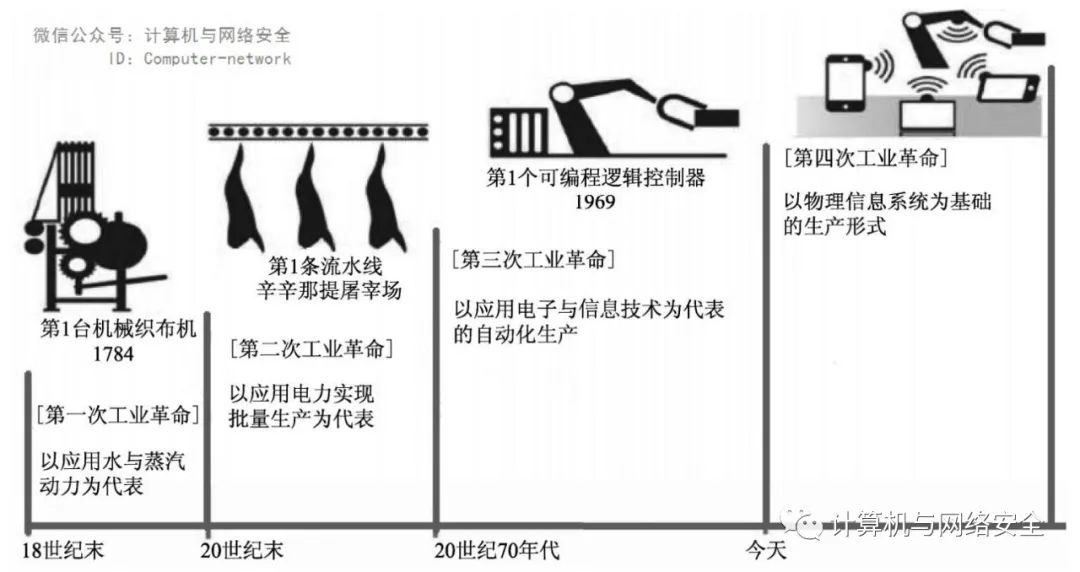
Figure 4 Overview of the Development of Four Industrial Revolutions
(4) IoT and Intelligent Manufacturing
From “Internet +” to intelligent manufacturing, all rely on the technical support of the IoT. The IoT has been listed by the State Council as one of China’s key planned strategic emerging industries. In fact, in recent years, intelligent manufacturing has also achieved brilliant results.
1) China has developed an aerial building machine, challenging the construction of super-tall buildings, leading the world. The aerial building machine, equipped with numerous sensors and controllers, has a lifting capacity of over four thousand tons, making it easy to conduct construction operations at a kilometer high. It can also operate stably in winds of level 8, and its construction speed of one floor every four days is astonishing both domestically and internationally.
2) China’s tunnel-erecting machine has shocked the world. In recent years, the rapid development of China’s high-speed rail has attracted global attention. The unique mechanical equipment behind the speed of “breaking roads in the mountains and erecting bridges in the water” is the tunnel-erecting machine. The machine is equipped with hundreds of sensors on all sides, featuring steering, anti-collision, and speed measurement functions. Based on data from these sensors, the operational status of the tunnel-erecting machine can be determined, enabling precise control of construction operations.
3) China’s “tunnel digging artifact” – Tunnel Boring Machine (TBM). On December 24, 2015, China’s first dual-shield hard rock tunnel boring machine was successfully developed. This machine features fast excavation speed and is suitable for long tunnel construction. Each tunnel boring machine is equipped with detection and control systems that utilize IoT technology, such as vibration systems, and the sensors used include receiving sensors, rock-breaking seismic source sensors, and noise sensors.
Clearly, with the development of the IoT, the potential of China’s intelligent manufacturing technology is continuously being stimulated, showcasing vibrant vitality.
Editor: Song Jianan
Editor-in-Chief: Wang Ziyue
Image Source: Computer and Network Security
Reviewers: Gu Hong, Zhang Jian, Wang Yao, Feng Linshu
Previous Reviews
|
1 |
At this snow盛|Make a deep promise with Tianzhi to grow old together |
|
2 |
Spend a “different” year, preserving a memory in the youth album |
|
3 |
On-the-job practice, helping dreams grow – welcome meeting for interns at Trelleburg Kindergarten |
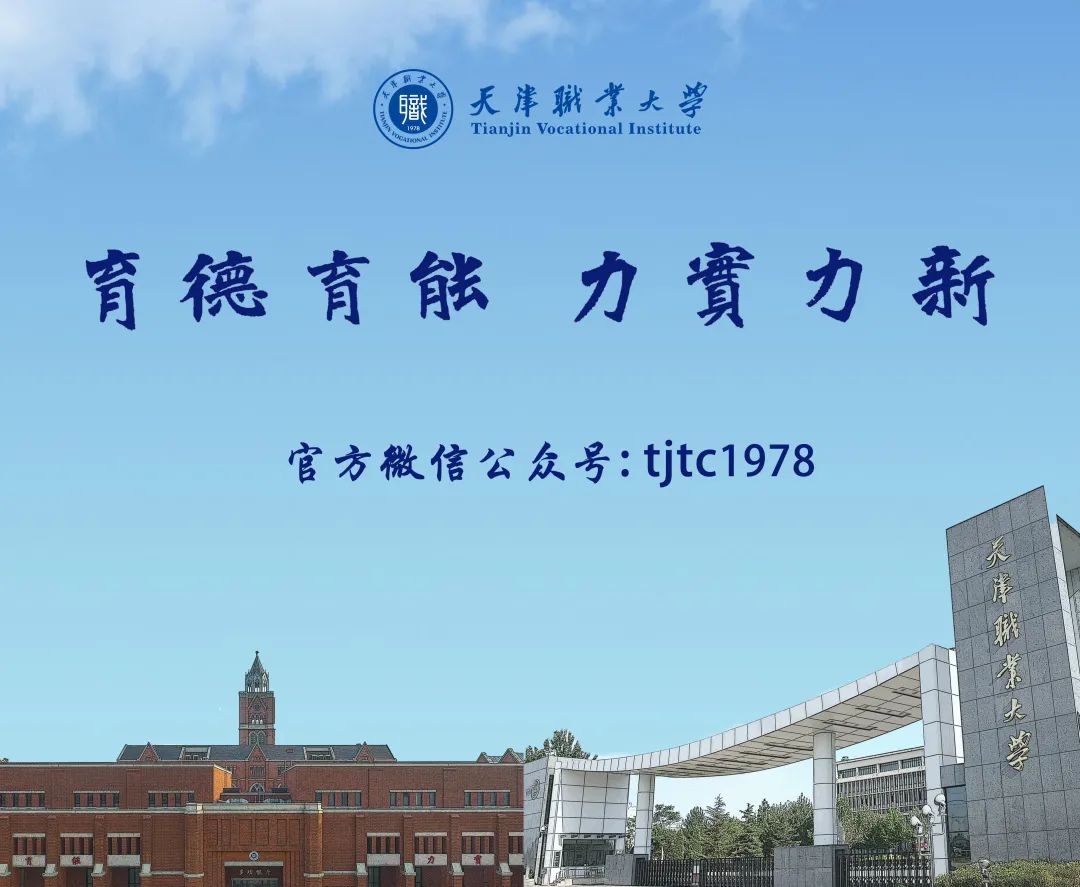
Like, let me know youare watching
